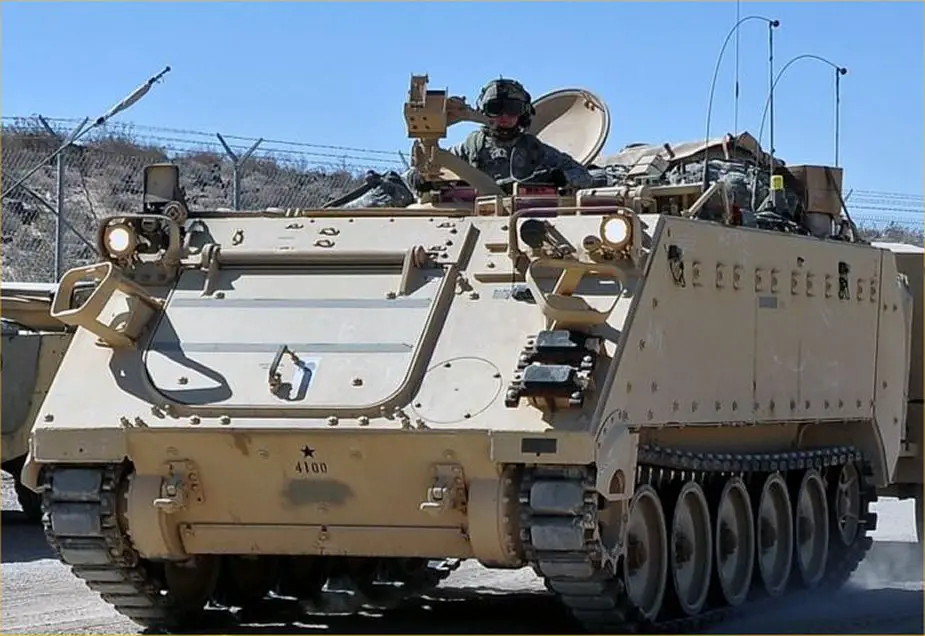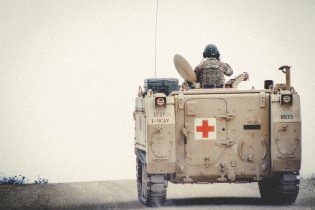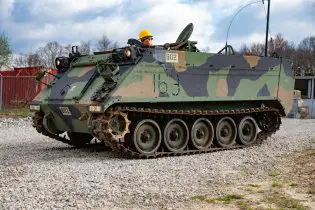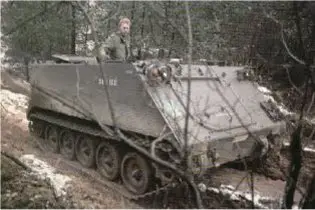- Army
- Air Defense Systems
- Anti-tank systems and vehicles
- Armored Vehicles
- Armoured personnel carriers
- Artillery Vehicles and Weapons
- Command Post
- Communication Vehicles and Systems
- Electronic Warfare
- Engineer | Maintenance Vehicles
- Infantry Fighting Vehicles
- Main Battle Tanks
- Missiles
- Tactical and Logistic Vehicles
- Radars
- Unmanned Systems
- Weapons
- Navy
- Air
M113A3 APC
M113A3 APC
Armored Personnel Carrier Vehicle - United States

Description
The M113A3 is an upgraded version of the M113 family of vehicles, which served as the main armored personnel carrier (APC) for the US Army in the 1980s. The upgrade was undertaken to improve the overall performance of the M113 fleet, addressing its deficiencies in terms of protection and mobility.
In the earlier models of the M113, firepower was considered adequate for an APC, but its protection and mobility were outdated. With a lower engine power and top speed compared to the M1 Abrams MBT and M2 Bradley IFV, the M113A2 lagged behind its counterparts. However, replacing the entire M113 family with Bradley variants proved to be technically, logistically, and financially impractical. The decision was made in 1984 to upgrade the M113s instead.*
The upgrade, collectively known as the RISE (Reliability Improvements for Selected Equipment), aimed to equip the M113A3 with spall liners, a more powerful engine and transmission, new driver controls, external fuel cells, shock-absorbent seats, new brakes, and provisions for additional armor. From 1987 onwards, all newly built M113s were manufactured to the A3 standard, and upgrades to existing vehicles have been implemented since 1989.
M113A3 variants:
-M113A3 Armored Cavalry Assault Vehicle (ACAV): Standard APC with a 360-degree gunshield around the commander's cupola and two gun-shielded 7.62 mm machine guns installed over the cargo hatch.
-M58A3 Wolf: Smoke generator vehicle.
-M106A3: 106 mm mortar carrier.
-M577A3: Mobile C3I (Command, Control, Communications, and Intelligence) vehicle with a tall roof. Unlike most M113A3 variants, it cannot swim due to increased weight and height.
-M901A3 Improved TOW Vehicle (ITV): Tank destroyer equipped with a TOW anti-tank guided missile launcher.
-M981A3 FISTV: Fire Support Team Vehicle used to organize, call-in, direct, and correct artillery fire.
-M1059A3 Lynx: Smoke generator vehicle.
-M1068A3 SICPS: Standard Integrated Command Post System (SICPS), essentially an M577A3 with more advanced C3I capabilities.
Technical Data
| Armament |
|
The M113A3 can include various weapon systems including a ring-mount or a remotely operated weapon station armed with a 7.62mm M240 machine gun, a 12.7mm M2HB heavy machine gun, or a 40mm Mk.19 automatic grenade launcher. Additionally, up to four soldiers can engage in combat from the cargo hatch, often supported by shielded machine guns. This machine gun can be used for close defense against lightly armored targets and enemy troops. It provides additional firepower to support the troops transported inside the vehicle.
In addition to its turret-mounted machine gun, the M113A3 armored vehicle can be equipped with various other weapons based on operational requirements. These include light 7.62mm caliber machine guns mounted on gun-shielded mounts on the cargo hatch, allowing up to four soldiers to engage in combat from within the vehicle. Furthermore, the available space on the vehicle's roof allows for the installation of additional weapons such as light anti-tank guided missile launchers, 90mm recoilless rifles, and 60mm mortars. However, it's important to note that these additional weapons are not standard equipment and are tailored to specific mission needs. |
| Design and protection |
|
The vehicle's design is similar to the previous version of the M113, and it can accommodate up to 11 military personnel, including a driver and a commander/gunner. At the rear of the vehicle, ten fully-equipped infantrymen are seated on side benches, arranged in a configuration of five individuals facing each other. The driver occupies the front left position, with the engine located to the right, while the vehicle's commander/gunner sits at a central location, overseeing operations and coordinating the movements of the onboard team.
The M113A3 has a box-like appearance with a well-sloped glacis plate and an inwardly-sloped rear. It features a large trim vane on top of the glacis plate, pioneer tools stored above it, and pairs of headlights with collision guards on each side. Smoke grenade dischargers are often mounted on the upper glacis plate. The rear end of the vehicle is characterized by a ramp with a hinged door on the left side, flanked by large fuel cells. The roof is equipped with various fixtures, including hitches for attaching additional armor, a cargo hatch, and a commander's cupola with a machine gun mount. The front of the roof houses the driver's hatch, engine ventilation, and exhaust louvers. The armor of the M113A3 remains unchanged from previous models, using 5083 aluminum alloy. It is 44 mm thick over the frontal arc, 38 mm thick over the sides, rear, and roof, and 28 mm thick over the belly. While this armor provides protection against anti-personnel mines, small arms fire, shell splinters, and blast overpressure, it is vulnerable to vehicle-fired anti-tank munitions and continuous heavy machine gun fire. Spall liners and a collective NBC (nuclear, biological, chemical) protection system are standard on all A3 variants. Optional appliqué armor kits for protection against larger rounds were offered but not widely fielded by the US military. Some M113A3s operating in Iraq have been fitted with bar armor cages and 25 mm ballistic steel plates as interim measures against shaped charge warheads. To enhance protection, spall liners and a collective NBC (Nuclear, Biological, Chemical) protection system are standard on all A3 variants. Additional armor kits for protection against larger calibers were offered by BAe, but they were not widely adopted by the US military. Some M113A3s in service in Iraq were fitted with bar armor cages and 25 mm ballistic steel plates as an interim measure against shaped charge warheads. |
| Mobility |
| The M113A3 is propelled by a General Motors 6V53T diesel V6 engine with 275 horsepower, replacing the previous engine models. It is coupled with an Allison X-200-4 or X-200-4A automatic transmission, offering four forward gears and two reverse gears. The vehicle's torsion bar suspension allows it to carry up to 10 tonnes of payload, and its running gear consists of five road wheels on each side, a flat track, and a front-drive sprocket with a rear idler. With a power-to-weight ratio of approximately 22.35 horsepower per tonne, the M113A3 has a top speed of 72 km/h and a range of 480 km. Optionally, Soucy band tracks can be fitted to increase its top speed to 80 km/h and extend its range to 640 km. |
| Combat Equipment |
| The M113A3 is equipped with improved electronics compared to earlier models. It features new controls, gauges, and image intensification night vision equipment for the driver. The A3 variant also includes upgraded radios. The M113A3 is fully amphibious without the need for any preparation. It has bilge pumps to assist with swimming and prevent water accumulation inside the vehicle. The ability to operate in the water adds to the vehicle's versatility and mobility. The M113A3 can be fitted with various additional equipment to enhance its protection and mission capabilities. While the list is extensive, it includes features such as smoke grenade dischargers, pioneer tools, cargo hatches, and cylindrical hitches for attaching appliqué armor and accessories. |
Specifications
| Armament | Armor |
| One machine gun, 12.7 or 7.62mm caliber | Protection against the firing of small arms and artillery shell splinters |
| Country users | Weight |
| Canada, Australia, United Kingdom, Germany, France, Italy, Japan, South Korea, Saudi Arabia, United Arab Emirates, Turkey, Israel, Brazil … | 12,300 kg |
| Designer Country | Speed |
| United States | 72 km/h maximum road speed, 5,8 km/h on water |
| Combat Equipment | Range |
| Smoke grenade launchers, gun shields, weapon stations, communication equipment, night vision devices, mine roller systems | 480 km |
| Crew | Dimensions |
| 2 + 11 infantrymen | Length:5.2 meters; Width: 2.6 meters; Height: 2.5 meters |
Details View
 |
 |
 |
 |
Pictures - Video



























